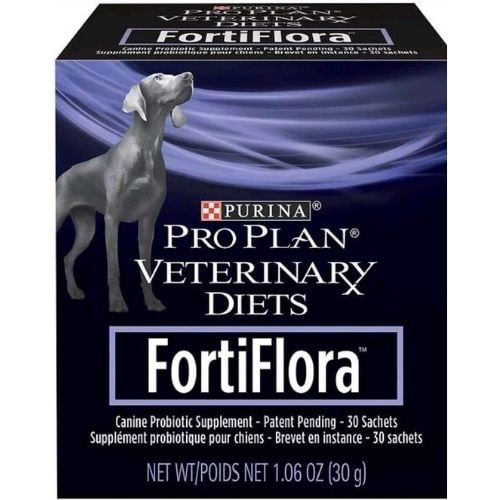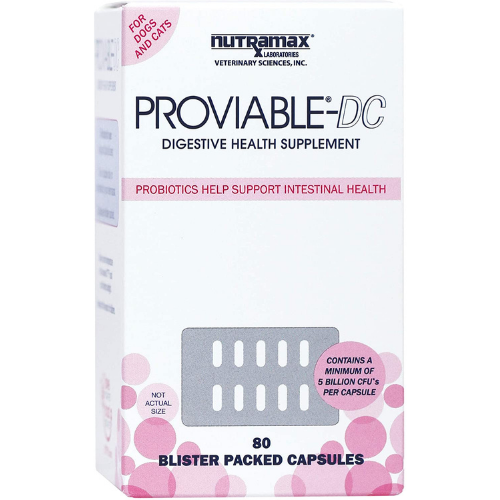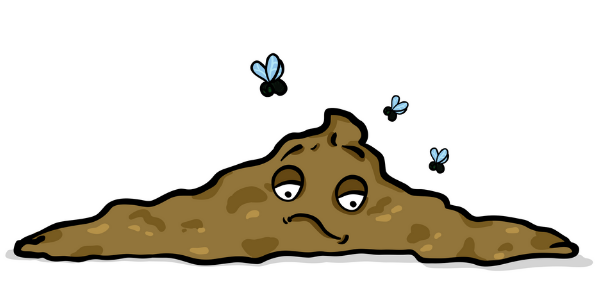 You have likely heard the diarrhea song at some point in your life. While the song is funny, there isn’t anything funny about your dog having diarrhea, especially when traveling or during the holidays.
You have likely heard the diarrhea song at some point in your life. While the song is funny, there isn’t anything funny about your dog having diarrhea, especially when traveling or during the holidays.
If your dog falls into one of these groups (puppies, seniors, or immunocompromised dogs), don't wait — head to the vet right away. The longer you wait, the worse things can get.
No one wants to become a diarrhea expert but knowing why your dog has the runs and how to handle it can save your dog from serious complications. Understanding the basics — what causes it, how to treat it at home, and when to call your vet is essential.
We’ll explore some practical tips and remedies to tackle dog diarrhea and restore your pup's digestive system to optimal health.
I’m here to help you (hopefully!!) get through this messy situation. Let’s get into it.
Skip to Section:
How to quickly assess your dog's diarrhea
When diarrhea may be treated at home
How to treat dog diarrhea at home
Over-the-counter diarrhea medications
What if home treatment doesn't work?
Be prepared to answer the vet's questions
Quick Assessment Guide
Diarrhea in dogs is a common condition that is a sign or symptom of other diseases or issues rather than a disease itself.
There are two main types of dog diarrhea:
Sudden (Acute):
- Starts quickly
- Usually lasts a few days
- Often caused by eating something they shouldn't
- Typically clears up on its own or with simple treatment
Long-lasting (Chronic):
- Continues for more than 2 weeks
- May signal a deeper health issue
- Definitely needs a veterinarian's attention
- Usually requires testing to find the cause
Diarrhea is fecal matter moving through the intestines faster than normal, causing a decrease in absorption of water, nutrients, and electrolytes.

When Diarrhea Is a Medical Emergency
- You suspect your dog has ingested a toxin or poison
- You suspect your dog has eaten a foreign body, such as a toy, bone, or piece of fabric
- Your dog is low energy and may seem weak
- Your dog has lost their appetite
- Your dog is throwing up (typically more than once or any time they consume water and/or food). Always contact a veterinarian if you see any blood, even if they vomit only once.
- Frequent bouts of diarrhea repeated over a 2-hour window of time
- The diarrhea has lasted more than 24 to 36 hours despite home remedies
- Your dog is dehydrated in addition to having diarrhea. Signs of dehydration include dry mucous membranes (gums and inner cheeks), sunken eyes, elevated heart rate, or a ‘skin tent’ is present.
- How to check for a "skin tent”: Simply lift the skin and fur at the nape of your dog’s neck. If the skin and fur don’t go back immediately, your dog is likely dehydrated.
For those who are severely dehydrated, the skin will remain tented. This is a critical situation, especially for puppies, senior dogs, or those with underlying medical issues — medical attention is needed immediately.
- There is a lot of blood (red) in the poop – small spots of blood are not necessarily an emergency
- The stool is black and /or tarry
- Your dog is continually straining to poop, and not much is coming out
- Your dog is whining when trying to poop
- Your dog’s gums are pale, bluish, whitish, or gray in color
- Your dog’s stomach is painful (rapid panting, groaning, or avoiding being touched) and bloated
- Your dog is passing worms in their stool, or you see worms in their vomit
Diarrhea is one of the most common problems that bring dogs into the vet. Even a mild case can become serious if not treated early enough.
When in doubt, call your veterinarian or an emergency hospital for advice.
For $5, you can connect with a veterinarian to discuss your dog’s diarrhea issue.
Connect now
Rates may differ for those residing outside the U.S. You'll have access to a vet for 7 days.
When Diarrhea May Be Treated at Home
- Your dog is acting normally
- Normal energy
- Normal appetite
- Normal drinking habits
- No vomiting
- No signs of nausea:
- No drooling
- No panting
- No repeatedly swallowing
- No lip licking
- No retching
- Your dog is up–to–date on their vaccines (such as vaccines for parvovirus or distemper virus)
- Your dog has been dewormed and is on a preventative
- Your dog is a young adult (not very young or old)
- There are no pre-existing health issues such as Addison’s disease, kidney failure, cancer, etc.
Skip to the section on how to treat your dog’s diarrhea at home >>
If you've got a multi-dog home and aren't sure which of your dogs is having diarrhea — try this colorful trick to ensure you're treating the right dog.
Causes of Dog Diarrhea

Dogs can become dehydrated and develop electrolyte imbalances. Therefore, knowing the possible cause of your dog's diarrhea helps you know when it is critical to seek medical care versus treating your dog at home.
There can be many causes of diarrhea in dogs. It is a symptom of diseases or other issues like toxins, foreign body ingestion, etc., that affect the small intestines, large intestines, or other organs outside the gastrointestinal tract.
In most cases, dogs will vomit or have diarrhea due to:
Stress, nervousness, or anxiety
Stress can trigger gastrointestinal upset resulting in stress colitis. There are numerous factors or situations that cause stress in dogs.
Such situations include, but are not limited to:
- Boarding
- Traveling
- Household visitors
- New pets or family members
- Changes in environment
- Separation from their owner
Understanding what causes your dog stress or triggers anxiety can help lessen issues with diarrhea.
Eating something hazardous
Some common toxins that give dogs diarrhea include:
- Grapes
- Chocolate
- Alcohol
- Onions and garlic
- Human medications, etc.
Foreign objects can also be very dangerous for dogs to ingest. These frequently include:
- Part of a dog toy
- Piece of a stick
- Underwear
- Socks, etc.
Additional symptoms of a toxin or foreign body include nausea, distended and/or painful abdomen, lack of appetite, lethargy, muscle tremors, seizures, changes in heart and respiratory rates, and behavioral changes.
Too many table scraps or fatty foods
Feeding your dog anything greasy, like bacon, etc., can upset your dog's stomach. Ingestion of table scraps or fatty foods can lead to pancreatitis.
Symptoms include nausea, lethargy, abdominal pain, change in appetite, and fever.
Food allergies or intolerances
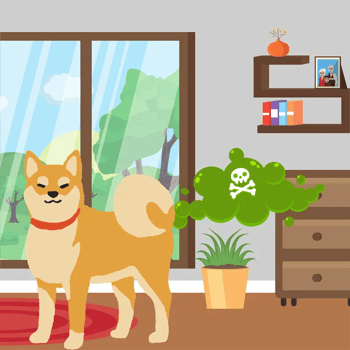 Food allergies typically develop after extended exposure to one type or form of food and can cause digestive issues such as vomiting or diarrhea (and smelly gas!).
Food allergies typically develop after extended exposure to one type or form of food and can cause digestive issues such as vomiting or diarrhea (and smelly gas!).
Other signs your dog may have food allergies or intolerances include itchy skin, paws or ears, weight loss, fatigue as well as behavioral changes such as aggression or hyperactivity.
Rapid food change
Switching between types or brands of dog food too quickly can upset your dog's stomach and lead to diarrhea. Their gut needs time to adapt to the new food.
Giving your dog a new treats without slowly introducing them can lead to diarrhea as well, especially if they are harder to digest such as jerky or rawhide treats or are you are trying a new veggie or fruit.
Note: This guide can help you choose the best dog treats.
Diarrhea can start as soon as a few hours after the diet change or can take a day to two.
Even if you think you are transitioning slowly, it may not be slow enough for your dog. Always monitor their stool throughout (and after) transitioning to a new diet or treat.
Inflammatory bowel disease (IBD)
IBD happens when your dog's intestines become inflamed and swollen, resulting in a thickened intestinal lining.
When this occurs, the digestion and absorption of nutrients are altered. In addition to vomiting and chronic diarrhea, dogs often have poor appetites and lose weight.
On the other hand, because the intestines are unable to digest and absorb nutrients, some dogs have an insatiable appetite.
Intestinal parasites
Dogs can pick up intestinal parasites in several ways:
- Drinking water contaminated with the parasite or its eggs
- Eating contaminated food containing the parasite or its eggs
- Licking surfaces or objects contaminated with poop from infected animals
- Sniffing, eating, or licking contaminated soil, such as in dog parks
- Eating a raw food diet
- Eating lizards, mice, or frogs
The worm eggs are microscopic, but you may see whole worms if your dog had roundworms. Dogs with intestinal parasites may have mucousy or bloody diarrhea.
Intestinal cancer
When dogs have intestinal cancer, additional signs vary based on where the cancer is located.
Symptoms for tumors located in the small intestines include:
- Decreased appetite
- Sporadic vomiting (may be blood-tinged or look like coffee grounds)
- Sluggish, inactive
- Abnormal gut sounds
- Frequent gas
- Gradual weight loss
 If there is ulceration or bleeding of the tumors in the small intestines, a dog’s poop will appear blackish or tarry. Continual bleeding will cause anemia, and a dog’s gums will be pale.
If there is ulceration or bleeding of the tumors in the small intestines, a dog’s poop will appear blackish or tarry. Continual bleeding will cause anemia, and a dog’s gums will be pale.
Tumors in the large intestines make it difficult for dogs to pass poop. There may be blood in the poop, and blood can drip from the anus. There can be a change in the size (narrow) and shape of the poop (ribbon-like).
If tumors develop where the small and large intestines meet, your dog may have a combination of symptoms.
Metabolic disease
These can include kidney disease, pancreatitis, thyroid disease, and others.
These conditions cause diarrhea since they can alter the motility or environment of the gastrointestinal tract.
For example, dogs with liver disease can have yellow or white stool due to a lack of, or change in, the production of bile (bile gives poop its brown color).
Viral or bacterial conditions
Bacterial conditions like hemorrhagic gastroenteritis (HGE) can cause diarrhea. This acute disorder is characterized by not only vomiting and diarrhea but also abdominal pain, lack of appetite, lethargy, or fever. It can occur without warning and can be the result of a toxin or immune-mediated disease.
Learn more about hemorrhagic gastroenteritis (HGE) below.
Reaction to medications
Just like people can experience side effects from medications, so can dogs.
These side effects can be caused by the type of medication (e.g., antibiotics, NSAIDs), the dose of medication, how the medication was administered (given with or without food or given with other medications), additives in the medication (e.g., lactose) or your dog’s overall health and age.
Organ dysfunction
There are organs outside the intestinal tract that can potentially cause diarrhea.
Diseases that affect the kidneys, liver, and pancreas can all cause diarrhea.
How to Treat Your Dog's Diarrhea at Home
There are times when your dog may be off, and you can manage their diarrhea without a trip to the veterinarian.
If you have determined that it will likely be ok to try and “ride out” your dog’s diarrhea for 24 to 36 hours, then here are some home treatment options.
Rest
Like humans, dogs need rest when they're sick. Set up a cozy recovery spot for your pup that's both practical and comfortable:
- Close to a door for quick bathroom trips
- On an easy-to-clean floor in case of accidents
- Away from noise and activity
Note: For a quick and effective cleaning option, especially during the middle of the night, the iClean mini is a lifesaver. It turns regular tap water into a sanitizing spray.
You do not have to rinse this product, so you can pick up the mess, spray, and walk away. It is completely safe if your dog licks or walks through the cleaned area.
Fasting
Ideally, fast your dog for 12 hours to allow their gastrointestinal tract to rest and recover. This means NO treats, regular meals, snacks – food of any kind.
NOTE: Contact a veterinarian BEFORE fasting puppies and toy/small breed dogs. They are at risk of developing hypoglycemia (low blood sugar) if they do not eat routinely. If this occurs, it can further complicate your dog’s situation.
NOTE: If your dog is diabetic, do not fast your dog and administer insulin at their regular dose. Contact your veterinarian for advice before fasting your dog or adjusting insulin doses.
Additionally, if your dog has any underlying medical issues and they develop diarrhea, consult with your veterinarian before fasting and diet changes.
Hydration
Keeping your dog hydrated is crucial when they have diarrhea. One of the best options is rice water, which offers several benefits over plain water:
- Helps with digestion
- Reduces gas and bloating
- Provides essential minerals
- Gives them energy through simple carbohydrates
You want to use good quality white rice (not minute rice). Brown rice is not recommended since it has too much fiber.
How to make rice water
Ingredients:
- 1 cup of white rice
- 4 cups of water
Instructions:
Boil 1 cup of white rice in 4 cups of water for 10 to 30 minutes (maybe longer) until the water turns a creamy white color. Remove the liquid and allow it to cool.
Save the cooked rice for later use. Cool the cooked rice as quickly as possible and store in an airtight container in the fridge for 3 to 6 days. You can also freeze it for up to 6 months.
Once the rice water is cooled, give it to your dog as often as they will consume it.
Note: Do not fill your dog’s dish full of rice water. Some dogs will drink too much or too fast, which can result in vomiting.
Start with small amounts frequently and gradually increase the volume.
- For toy and small breeds, offer about 2 to 3 mls every 30 to 60 minutes
- For medium and large breed dogs, you can start with ⅛ cup to ¼ cup every 30 to 60 minutes
For those dogs not interested in plain rice water, you can add a couple of teaspoons of low sodium chicken broth powder or dog-safe bone broth (be sure it does not contain any onions or garlic).
You can even add it to their regular drinking water just to help improve hydration. But as with the rice water, start with a small serving and gradually increase.
Alternatives to rice or flavored water
If you find that rice water isn’t your dog’s thing, you can try clear, unflavored Pedialyte. Personally, I think the stuff tastes terrible and would prefer the rice water!
I do not recommend Gatorade because it is high in sugar, and that can cause further intestinal inflammation. There are electrolyte solutions made specifically for pets, as well.
After Fasting
After the 12-hour fast (see above for details on fasting), here's how to start feeding your dog again:
-
Start Small
-
Begin with tiny portions of bland, easy-to-digest food
-
Feed small amounts every few hours
-
-
Slowly Increase Portions
-
Small dogs: Add ½ to 1 tablespoon at a time
-
Large dogs: Add ¼ cup at a time
-
Only increase if your dog is keeping food down
-
-
Build Back to Normal
-
Over 24–48 hours, work up to their usual daily amount
-
Split this into several small meals throughout the day
-
-
Stay Safe
-
Keep feeding the bland diet for 1–2 weeks after diarrhea stops
-
This gives your dog’s gut time to fully heal
-
Bland Diet Options
Option 1. Plain, boiled, boneless, skinless chicken or turkey and rice (the leftover from the rice water).
Option 2. Chicken or turkey baby food (be sure it does not contain onions or garlic – the links we provided are pet-safe baby food choices)
Option 3. Cooked and well-drained lean ground beef, ground turkey, or ground chicken. You can add some boiled, plain rice, baked plain sweet potato*, plain cooked pasta, or plain oatmeal.
*Do not use canned sweet potatoes as they are often too high in sugar and sodium.
Serving Size Example:
Small/Toy Dogs: 1–2 tablespoons of mixture
- 1/3 meat
- 2/3 rice or starch
Medium/Large Dogs: 1/8 to 1/4 cup of mixture
- 1/3 meat
- 2/3 rice or starch
Once you determine your dog's starting amount, give it every hour for a couple of hours. Then, allow them to rest for a couple of hours.
If your dog keeps their food down and there’s no more diarrhea, you can slowly increase their portions. Plan to feed several small meals throughout the day instead of their normal larger meals.
Option 4. There are prescription veterinary diets that work well as bland diet alternatives if cooking isn’t your thing! Royal Canin Digestive Low Fat, Hills I/D, Purina EN, or others. It is always helpful to regularly keep a couple of cans or packets at home.
Pro-Tip: If your dog recovers and you have leftover dry GI food, you can keep it fresh by putting it in a Ziploc® bag and placing it in the freezer for emergency use.
The Under the Weather bland diet does not require a veterinary prescription, so you can buy some ahead of time and keep it just in case. They have many flavors, so be sure to pick the one that matches the protein your dog is currently on, i.e., chicken.
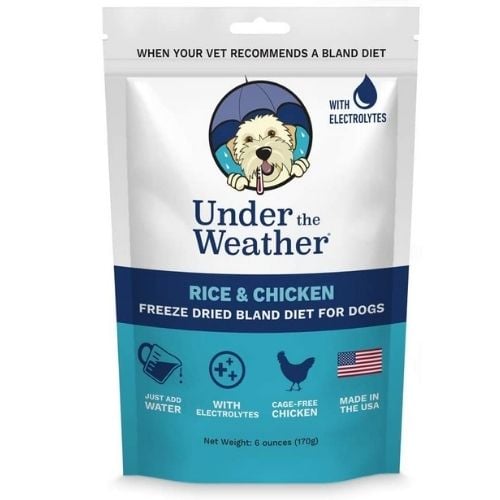
How Long to Keep Your Dog on a Bland Diet
Generally, you will keep your dog on a bland diet for one or two weeks. During that time, continue feeding small amounts every 3 to 4 hours. If the diarrhea goes away, then over another one to two weeks, you will slowly transition them back to their regular dog food diet.
Stick to just their regular food for now — no treats or other types of food. After they've been back on their normal food for 2 weeks with no problems, you can slowly start giving treats again.
Note: When re-introducing treats, start by using easy to digest options, such as Purina Pro Plan Gentle Snackers.
If you switch back to your dog's regular food too quickly, and don't leave enough time for healing and reduction of inflammation, you could end up right back where you started.
Other Things That Can Help with Diarrhea
In addition to rest, fasting, and a bland diet, there are some other things you may find helpful in dealing with diarrhea issues at home.
Probiotics
Probiotics may be helpful when dealing with diarrhea. Since the digestive tract makes up about 60 to 80% of your pet’s immune system, keeping it healthy is important.
Probiotics help by keeping the intestinal bacteria in good balance and aiding in digestion.
You can try regular, unflavored, probiotic-rich yogurt (you want as low a sugar content as possible – 10 grams or less of added sugar per serving), or you can pick up a probiotic like Purina’s FortiFlora, Nutramax’s Proviable, VetriScience Fast Balance GI Paste, or VetriScience Vetri Probiotic BD.
Note: If you notice that your dog’s diarrhea is triggered by stress, consider using Purina Pro Plan Calm Care as their probiotic. In addition to this probiotic, you can give them VetriScience Composure treats or Nutramax Solliquin daily.
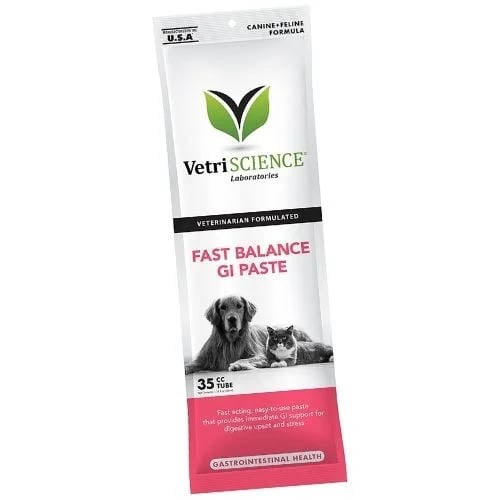
Fiber
Fiber, such as pumpkin, has been found to help with some cases of diarrhea. It acts as a prebiotic because it stimulates the growth of beneficial bacteria by lowering the pH and providing the nutrients they need. Plus, it helps fight off bad bacteria in your dog's gut.
Bananas can act in a similar manner as the pumpkin in that they help absorb water, decrease bowel movements by slowing down peristalsis, and they are a good source of potassium.
BUT bananas are high in sugar which isn’t ideal for dogs who are overweight or diabetic.
Psyllium fiber can be purchased over the counter as whole husks, in products like unsweetened, unflavored Metamucil, or this dog-formulated fiber brand.
Mix psyllium into food:
- Small dogs: 1 teaspoon, 1-2 times daily
- Large dogs: up to 3 teaspoons, 1-2 times daily
Tip: For pickier dogs, try grinding it into a finer powder.
WARNING: Do not use any of the flavored varieties of Metamucil, especially those with chocolate. Additionally, read the labels to be sure they do not contain xylitol – it is very toxic to pets.
NOTE: When using fiber as a dietary supplement, be sure that your dog is getting adequate amounts of fresh water. If not, this can increase the risk of dehydration.
Catnip
 Catnip, when used in moderation, is safe for dogs (not just cats) and can actually be beneficial to them. Since catnip is a plant, it is made up of several beneficial elements, such as vitamins, minerals, flavonoids, tannins, and oils.
Catnip, when used in moderation, is safe for dogs (not just cats) and can actually be beneficial to them. Since catnip is a plant, it is made up of several beneficial elements, such as vitamins, minerals, flavonoids, tannins, and oils.
With that said, do not give your dog catnip cat toys. This can result in choking or a potential intestinal obstruction.
Catnip has been found to have a sedative effect on dogs. However, this only occurs when they eat it, and a little goes a LONG way. Unfortunately, it is hard to predict its effects. Additionally, some dogs can become hyperactive instead of sedate.
Catnip has been found to help some dogs with indigestion, cramps, diarrhea, and gas. Again, only a small amount is needed (see the calculator below).
If you don't already have catnip lying around the house, we recommend Organic Cat Crack and Skinny Pete's Organic Catnip for Dogs.
How Much Catnip Can You Give Your Dog?
The average dose is 1/8 tsp to ½ tsp of dried catnip per kilogram of your dog's body weight (1 kilogram = 2.2 pounds). Use the calculator below to figure out how much catnip your dog should get. Always start at the lower end of the range since your dog's reaction cannot be predicted.
For example, if your dog weighs 30 pounds (13.61 kgs), divide 13.61 by 8 = 1.7 teaspoons for the low range of catnip. For the high range, divide 13.61 by 2 = 6.8 teaspoons. So, a 30 lbs dog would get between 1.7 and 6.8 teaspoons of catnip.
Promote Healing
Rebound Recuperation Formula for dogs can also be very beneficial. While it isn’t a treatment for diarrhea, it acts as a support for recovery. It helps promote hydration, which is important when dogs have diarrhea. It contains prebiotics and antioxidants, which are essential in helping to support the immune system for recovery. It also helps stimulate them to eat and drink.
Blood protein supplements might help your sick pup heal faster. These supplements contain special proteins that can:
- Reduce inflammation
- Speed up healing
- Support your dog’s immune system
- Improve digestibility of food
The WINPRO line of supplements (Immunity, Mobility, Allergy, Focus, Training) has been met with very positive feedback from dog owners. In our own experience, our dogs loved the taste of their supplements.
You only give your dog one or two (depending on their weight) each day, so a bag of 60 will last you 1–2 months. You should not give your dog more than the recommended amount.
Anti-diarrheal and stool firming medications can be toxic to your dog, especially if dosed incorrectly.
Anti-diarrheal and Over-the-counter Medications
Your veterinarian may recommend anti-diarrheal medications to help soothe your dog’s gastrointestinal tract and reduce the frequency of bowel movements. These medications can provide relief for your dog while the underlying cause is being addressed.
You may be wondering why I have not mentioned over-the-counter (OTC) human medications, such as Kaopectate®, Pepto Bismol®, or Imodium®, for your dog. The reason is that depending on the cause of the diarrhea, these medications can do more harm than good. They should only be given if recommended by your dog’s veterinarian and only at the dose they advise.
Pepto Bismol’s and Kaopectate’s active ingredient is bismuth subsalicylate. This ingredient is a derivative of salicylic acid or aspirin. If your dog gets the wrong dose, toxicity can result.
If your dog has intestinal bleeding that you are not aware of, bloody vomit and diarrhea, abdominal pain, and weakness may result. These medications may also affect platelet function, which can affect blood clotting times. When blood does not clot, bleeding continues, which can lead to other issues.
If given with any non-steroidal anti-inflammatory such as Rimadyl®, DeramaxxTM, etc., there is an increased risk of intestinal ulcers or perforation. It can cause your dog’s stool to look blackish.
Blackish stool in dogs is referred to as melena (digested blood in stool) which can indicate serious medical conditions. This can make diagnosing certain medical issues difficult and possibly add the need for more costly tests.
Lastly, the tablet forms of these medications containing bismuth (check the ingredient list for this chemical element) will appear radio-opaque (white) on X-rays. This can be mistaken for a metallic object and result in unnecessary surgery or other treatments.
Warning if you have a cat: If you have been advised by your veterinarian to give either Pepto Bismol or Kaopectate to your dog and you have a cat, do not let your cat consume these medications. They will cause salicylate toxicity. This can result in anemia, ulcers, and liver failure, regardless of how much they consume.
Why You Should Use Extreme Caution with Imodium®
Imodium (which goes by the generic name Loperamide) is a synthetic opioid. All opioids are known to cause constipation. They work by slowing down gut motility which allows for more fluid and salts to be drawn back into the body system.
Imodium, when administered at safe levels, is not helpful for pain and, therefore, will not relieve any abdominal discomfort your dog may have.
While, in some cases, Imodium may help, there are others where it can cause potentially serious side effects. Some of these side effects include constipation, sedation, bloating, and even pancreatitis.
You should never give Imodium to your dog if:
- Your dog is a herding breed (Sheltie, Australian Shepherd, Collie, etc.). Many herding breed dogs carry a mutant form of the ABCB1 -1 Δ gene that significantly limits their ability to break down certain drugs.
- If your pet has ingested a toxin or has an infection. The diarrhea is a way for their body to flush itself out and remove toxins and infections.
- If your pet has any medical conditions that can make them more susceptible to the negative side effects of the drug. Some health conditions are:
- Liver disease
- Kidney disease
- Hypothyroidism
- Addison’s disease
- If your pet is vomiting, has abdominal pain (groaning, rapid panting, avoiding being touched, etc.), and is weak.
- If your pet is very young or old.
What If Home Treatment Doesn't Work?
When in doubt, when concerned, or when the diarrhea extends beyond a day or two, despite your best at-home efforts, your best bet is to have your pet — and their poo — evaluated by your veterinarian.
No amount of internet searching and no number of trial and error home remedy attempts can compete with the comprehensive history taking, thorough physical examination, diagnostic testing, and the ability to prescribe safe and effective medications or supplements that only your veterinarian can offer.
Dehydration Is a Big Concern
Diarrhea causes dehydration because your dog is losing more fluids than they can take in. This lack of fluid balance prevents their bodies from functioning properly.
In severe cases, your dog may require hospitalization for intravenous fluid therapy. This treatment helps to quickly replenish lost fluids and electrolytes, stabilizing their condition.
Diarrhea Can Cause Nutrient Deficiency
The small intestine is where dogs absorb most of their nutrients from what they ingest. Therefore, when the cause of diarrhea relates to the small intestines, your dog is missing out on a lot of the nutrients they would normally gain from their food.
In addition to diarrhea, issues of the small intestines usually cause vomiting (increasing the risks of dehydration) and weight loss (because of the lack of nutrients).
For $5, you can connect with a veterinarian to discuss your dog’s diarrhea issue.
Connect now
Rates may differ for those residing outside the U.S. You'll have access to a vet for 7 days.
Be Prepared to Answer Your Veterinarian's Questions
Being able to answer your vet's questions about your pet’s diet, environment, habits, and behavior and knowing the details about your dog’s diarrhea will aid in narrowing the list of possible causes.
By narrowing the list of possible causes, this also helps determine if and what specific tests are needed or if you will be able to treat the issue with some medications at home.
Large vs. Small Intestinal Diarrhea
Diarrhea can start in either your dog's small or large intestine, and each type looks different and needs different treatment.
Help your veterinarian diagnose the problem by noticing and sharing these key details about your dog's diarrhea.
Characteristics of small intestinal diarrhea:
- Large amounts of stool
- Mild increase in frequency (3 to 5 bowel movements per day)
- No straining or difficulty pooping
- Often accompanied by vomiting
- Pets often lose weight
- Excess gas may be noted
- Prominent gut sounds may be heard
- If blood is present, it is digested, and the stool will look black or tarry
Small intestinal diarrhea can be caused by any of the following:
- Canine parvovirus
- Canine coronavirus
- Canine distemper
- Salmonella
- Clostridia
- Campylobacter
- Intestinal parasites
- Giardia
- Foreign bodies, such as sticks, bones, etc. that get stuck in the intestines
- Eating things your dog shouldn't or that disagree with their gastrointestinal tract
- Sudden changes in diet
- Inflammatory bowel disease
- Food allergies
- Toxins
- Intestinal tumors
Characteristics of large intestinal diarrhea:
- Small amounts of stool
- Increased frequency of pooping – greater than 5 times per day
- Your dog strains or has difficulty pooping
- If blood is present, it is bright red
- Stool may contain mucus
- Normally, vomiting is absent
- Dogs normally do not lose weight
Large Intestinal diarrhea can be caused by the following:
- Stress
- Whipworms
- Polyps
- Inflammatory bowel disease
- Cancer
- Colonic ulcers
As mentioned, there are organs outside the intestinal tract that can potentially cause diarrhea. Diseases that affect the kidneys, liver, and pancreas can all cause diarrhea.
What to Expect at the Vet Visit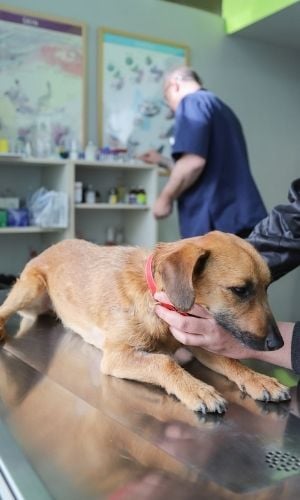
A Medical History
Like any good investigation, thorough questioning is crucial to the process of determining the cause of your pet’s problems. It’s true for your dog’s diarrhea. It’s true for ANY problems your pet might be having.
Typical historical questions your vet may ask when your pet is presented with diarrhea might include:
a) How long has the diarrhea been going on?
b) What does the stool look like — what color is it, is there any blood, etc.? Here’s where it’s really nice if you’ve brought a fresh sample of it – about 2 tablespoons, or at least a clear picture of it (I know, veterinarians have the best job, don’t we!)
Tip: If you can’t bring a poop sample, try to take a photo of it to share with your vet.
c) Is your pet on any medications or supplements?
d) What is your pet’s regular diet? This includes their dog food, treats (including human table food), and any other supplements. Take a photo of the bag and ingredient list if you can.
e) Have you given your dog any new treats or chews? This includes ones they have not had in a while, any human foods, rawhides, and non-rawhides, etc.
f) Has your dog recently gotten into the trash or compost?
g) Has your dog been around multiple other pets — including in your own home — and are those pets similarly affected?
h) If there are other pets in your home, are they on a different diet or get different treats?
i) Do you have a cat? Does your dog have access to their litter box?
k) Has your dog recently traveled, been boarded, or had any changes to their environment (new pets, visitors)
The list truly goes on and on and gets refined and adapted depending on your answers. History taking is truly an art… and a very important one at that!
Physical Examination
Your vet will evaluate and pick up on important things during the course of their physical examination.
During the physical exam, your vet will check:
-
For stomach pain or swelling, including the presence of fluid in their belly
-
For any unusual lumps or objects in the digestive tract and rectum
-
If their anal glands are infected (which can cause diarrhea)
-
Signs of dehydration or hypovolemia (low blood volume)
-
Their overall health
This hands-on exam helps your vet spot problems that might not be obvious and decide what treatment your dog needs.
Diagnostic Testing
Based on what your vet finds during the exam, they might need to run some tests to figure out what's causing the problem. (This is why it helps to know if your dog's diarrhea is coming from their upper or lower intestine — skip back to the section above to learn the difference!)
Your vet will choose which tests to do based on what they think is causing your dog's diarrhea.
Common tests your vet might run include:
- Poop Tests
- Checks for intestinal parasites and harmful bacteria
- Can quickly spot specific infections, like Giardia and canine parvovirus
- Blood Tests
- Shows if organs are working properly
- Helps find a possible condition that is causing the diarrhea, like pancreatitis
- Imaging
- X-rays or ultrasounds
- Shows any blockages or problems in the gut
- Endoscopy
- Uses a tiny camera to look inside your dog's digestive tract
- Allows the ability to take small biopsies (tissue samples)
Treatments
Some pets and some conditions require little to no treatment beyond a “bland diet” and “passage of time” to resolve the diarrhea. However, many cases and most that go on for greater than 24–48 hours need some treatment. What’s best, what’s safe, and what’s likely to be most effective will best be determined by the results of the veterinary exam.
Basic treatments often include intravenous fluids, medications to help stop the diarrhea (anti-diarrheal medications meant for dogs), dewormers, medications to treat nausea, and possibly pain medications. There are also times basic treatments involve dietary changes.
When the causes of diarrhea are more involved (food issues, disease, or cancer), more involved and specialized medications and treatments will be required. There are times when a referral to a specialist may be recommended.
It is important to regularly (several times per week) monitor your dog’s bathroom habits – even if they are shy about it! This helps you know what is normal and abnormal for them. It will alert you to problems sooner – which may avoid a vet visit.
These key pieces of information – changes in pooping habits, changes in poop color, firmness, amount, etc. – are very valuable when providing information to your dog’s veterinarian. It may save you a lot of time and possibly eliminate a lot of extra testing.
Frequently Asked Questions
What is diarrhea?
Diarrhea is the term used when your dog passes non-formed, loose, or watery stool more often and in larger amounts than they would normally defecate. It is a common condition that is a sign or symptom of other diseases or issues rather than a disease itself.
Diarrhea can be acute (sudden), lasting for 14 days or less, and is commonly due to eating something they shouldn’t have, sudden change in diet, or even stress. Most cases of sudden diarrhea either clear up on their own or get better with basic treatment.
Chronic diarrhea persists longer than 14 days, and can be the result of a more serious medical issue, such as food sensitivity or allergies, inflammatory bowel disease, exocrine pancreatic insufficiency, or cancer.
Chronic, long-lasting diarrhea usually needs a more complex treatment plan, often involving multiple steps and medications.
Can a dog get diarrhea from another dog?
Some causes of diarrhea are contagious, such as parvovirus. Therefore, a dog can get diarrhea from another dog.
What should dog poop look like?
Dog poop should be a range of brown shades in color, compact and segmented (log-like shape), moist, and easily picked up.
Why is my dog’s poop black?
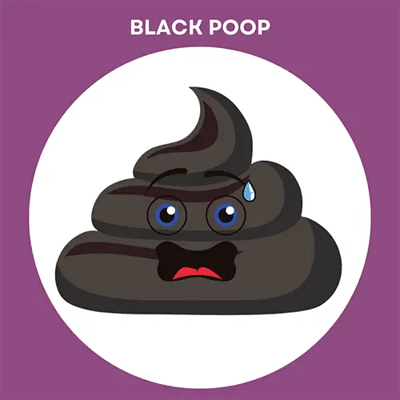 Eating certain dietary items, such as raw meat or foods containing charcoal or blood, can cause poop to be black.
Eating certain dietary items, such as raw meat or foods containing charcoal or blood, can cause poop to be black.
Black poop can indicate the presence of an underlying medical issue such as gastrointestinal bleeding, parasites, infection, or liver or kidney disease.
Some medications, such as iron supplements or bismuth subsalicylate (Pepto), can cause stool to be black.
Why is my dog’s poop yellow?
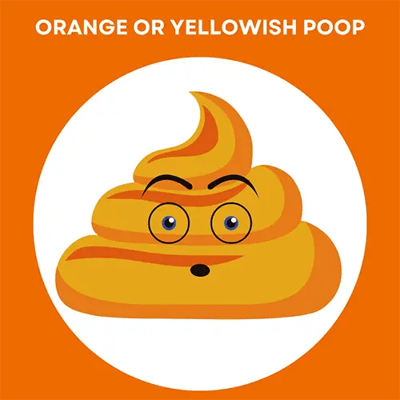 Yellow poop can be the result of diet change (feeding a bland diet), dietary indiscretion, food intolerances, parasites, bacterial or viral infections, and underlying diseases such as liver or gallbladder disease.
Yellow poop can be the result of diet change (feeding a bland diet), dietary indiscretion, food intolerances, parasites, bacterial or viral infections, and underlying diseases such as liver or gallbladder disease.
Why is there blood in my dog’s poop?
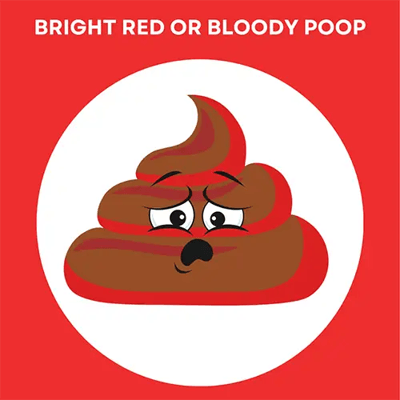
Bright blood (hematochezia) can indicate irritation (several bouts of diarrhea) or bleeding in the lower digestive tract (colon or rectum).
Bloody poop can also indicate:
- anal gland issues,
- parasites (hookworms)
- trauma
- toxins
- or inflammatory bowel disease
Why is there mucus in my dog’s diarrhea?
It can be normal for a little bit of mucus to be present in your dog’s poop. However, mucus, especially if a lot, can also indicate colitis (inflammation of the colon), stress, dietary changes, or parasites.
Is canned pumpkin good for dogs with diarrhea?
Canned pumpkin has been found to help with some causes of diarrhea. It acts as a prebiotic because it stimulates the growth of beneficial bacteria by lowering the pH and providing the nutrients they need. It also helps inhibit harmful bacteria in the intestines.
Do not feed canned pumpkin pie filling – it may contain allspice, cloves, and nutmeg, which can cause gastrointestinal issues for your dog. Additionally, the sugar in it can negatively impact diabetics and sugar can contribute to inflammation in your dog’s already irritated gastrointestinal tract.
Can a dog get diarrhea from eating too much?
If a dog eats too much, the overloaded gastrointestinal tract can’t absorb what it needs, and the stress of the discomfort and pain from a distended abdomen can result in diarrhea.
Can a dog get diarrhea from being overheated?
The stress of being overheated can cause a dog to have diarrhea.
How do you clean dog diarrhea from fabric, rugs, and carpets?
Act fast for the best results! You need to remove as much of the organic material from the fabric as possible.
Blot the area (use paper towels or an old rage) to remove as much liquid as you can – you may have to do this several times depending on the amount of diarrhea present.
Spray the area with an enzymatic cleaner (or an eco-friendly DIY cleaner) if safe for the type of fabric that has been soiled.
Allow the cleaner to sit for 5 to 10 minutes, and then blot up excess moisture. You may need to re-spray the area a few times to completely remove the stain. Once all the stain if gone, spray with cool or cold water and then gently blot again.
As a final disinfection, spray with the Tersano iClean mini.
DIY cleaner:
Dishwashing soap, such as Dawn – 1.5 tsps
White vinegar – 1 tablespoon
Warm water (use as warm as what is safe for the fabric) – about 2 cups
Should I give rice to a dog with diarrhea, and how much?
Adding a starch, such as rice, can help dogs suffering with diarrhea. Ideally, dogs should eat a bland diet fed in frequent mini meals when they have diarrhea.
For toy and small breed dogs, you would start with 1 to 2 tablespoons. Medium and larger breeds can be started with an ⅛ to ¼ cup.
Should I be concerned about my dog’s diarrhea?
A single episode of loose stool is likely not of concern. But if your dog isn’t eating and drinking normally, seems lethargic or weak, and they also are vomiting, it is necessary to seek veterinary care for your dog.
Should you withhold food from a dog having diarrhea?
Depending on your dog’s age, breed, and health status, fasting for about 12 hours may benefit them. Always consult with your veterinarian about fasting your dog, especially if they have underlying medical issues, such as diabetes.
What can I give a dog with diarrhea?
Feeding a dog a bland diet of boiled, boneless, skinless chicken, and plain boiled rice can be fed to your dog in small frequent meals. There are also other supplements that can be beneficial, such as probiotics or fiber.
It is important your dog stays hydrated when they have diarrhea since they can easily become dehydrated. You can use plain rice water, unflavored Pedialyte or an electrolyte solution made specifically for pets.
Is it safe to give my dog probiotics for diarrhea?
It is not only safe but beneficial for giving dogs with diarrhea probiotics meant for dogs.
Can I give human medication to my dog with diarrhea?
NO!
How can I keep my dog hydrated if they have diarrhea?
It is important your dog stays hydrated when they have diarrhea since they can easily become dehydrated. You can use plain rice water, unflavored Pedialyte or an electrolyte solution made specifically for pets.
What are some potential complications of prolonged diarrhea in dogs?
Prolonged diarrhea can result in severe dehydration, metabolic disturbances (electrolyte imbalances, changes in blood pressure), weight loss, and lethargy.
Can dogs get diarrhea from stress?
Stress or stressful events can cause a dog to get diarrhea.
Can a dog’s diarrhea cause bleeding?
Frequent bouts of diarrhea can cause irritation, which can result in bleeding.
Will my dog’s diarrhea go away on its own?
Some cases of acute diarrhea will resolve on their own. However, it is always better to have a dog evaluated and treated to avoid other complications.
How long is too long for a dog to have diarrhea?
If your dog has had diarrhea for more than 24 to 36 hours, seek veterinary care.
What are the causes of dog diarrhea?
There are many, many causes of diarrhea, ranging from minor causes such as stress or dietary changes to more serious medical issues such as metabolic diseases and cancer.
What are some home remedies for dog diarrhea?
Home remedies include mini meals of a bland diet, probiotics, fiber supplements, catnip, and rice water. NEVER give your dog human anti-diarrheal medications as they can be harmful and potentially fatal.
When should I call a veterinarian about my dog’s diarrhea?
Call your veterinarian if:
- Your dog has had diarrhea for more than 24 to 36 hours
- There is blood in the diarrhea
- They are vomiting
- They are lethargic or weak
- They are not eating or drinking
- They are dehydrated
What diagnostic tests might my veterinarian recommend for a dog with chronic diarrhea?
Your veterinarian may recommend several diagnostic tests, such as complete blood count (CBC), blood chemistry (evaluates body organ function), intestinal parasite analysis, radiographs, and/or specialized blood tests (evaluate for diseases such as Addison’s or Cushing’s).
How long does dog diarrhea last?
Depending on the cause, it can be acute, lasting less than 14 days, or chronic, lasting more than 14 days.
Should I worry if my dog has diarrhea but is acting fine?
Diarrhea is a sign or symptom of other diseases or issues rather than a disease itself. Therefore, a dog that has diarrhea is always a cause for concern.
When is dog diarrhea an emergency?
Dog diarrhea is an emergency any time there is blood in it and is accompanied by any other symptoms, such as vomiting, lethargy, fever, weakness, abdominal distention, abdominal pain, or dehydration.
What is hemorrhagic gastroenteritis (HGE)?
Hemorrhagic gastroenteritis is also known as acute hemorrhagic diarrhea syndrome (AHDS).
HGE is a potentially life-threatening intestinal condition that manifests as a sudden (acute) onset of watery, bloody diarrhea. About 80% of dogs will experience vomiting about 10 hours prior to the onset of the bloody diarrhea and about 50% of the time, blood is present in the vomit.
Do certain dog breeds or ages have a higher chance of getting HGE?
Dogs of any age, size, and gender can be affected.
It is most common in small and toy breeds, but any breed can be affected.
Breeds commonly affected include:
- Miniature Poodles (young)
- Miniature Schnauzers
- Yorkshire Terriers
- Bichon Frise
- Cavalier King Charles Spaniels
- Dachshunds
- Maltese
- Pekingese
- Poodles
- Shetland Sheepdogs
Once a dog has had HGE, what are the chances it will happen again?
Future reoccurrence is likely in dogs that experience HGE.
The syndrome needs to be treated promptly and aggressively since the dog deteriorates quickly and can die.
What causes hemorrhagic gastroenteritis (HGE)?
The exact cause is unknown. Some factors believed to contribute to the syndrome include bacteria (Clostridium perfringens), dietary indiscretion (food or non-food items), toxins, trauma, immune-mediated disease, and pancreatitis. Stress and anxiety may also play a role.
What are the symptoms of hemorrhagic gastroenteritis (HGE)?
The symptoms include:
- Bloody, watery diarrhea
- Vomiting
- Abdominal pain
- Pale mucus membranes
- Dehydration
- Lethargy
- Decreased appetite
How is HGE Treated?
Most dogs are hospitalized for treatment. Treatment may include one or more of the following:
- Intravenous fluids
- Anti-nausea medication
- Antibiotics
- Gastrointestinal protectants
- Pain medications
- Probiotics
- Severe cases may require plasma





